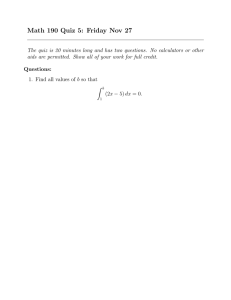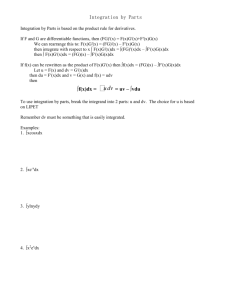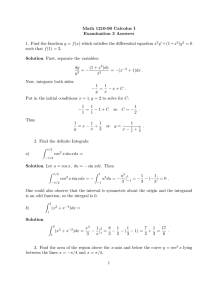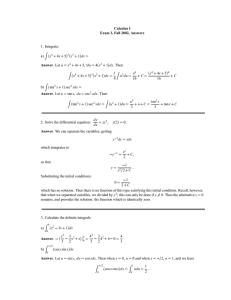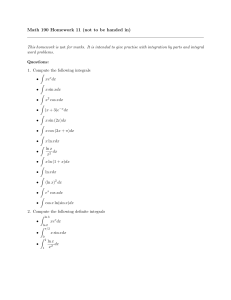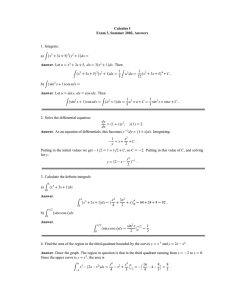Document 11890481
advertisement
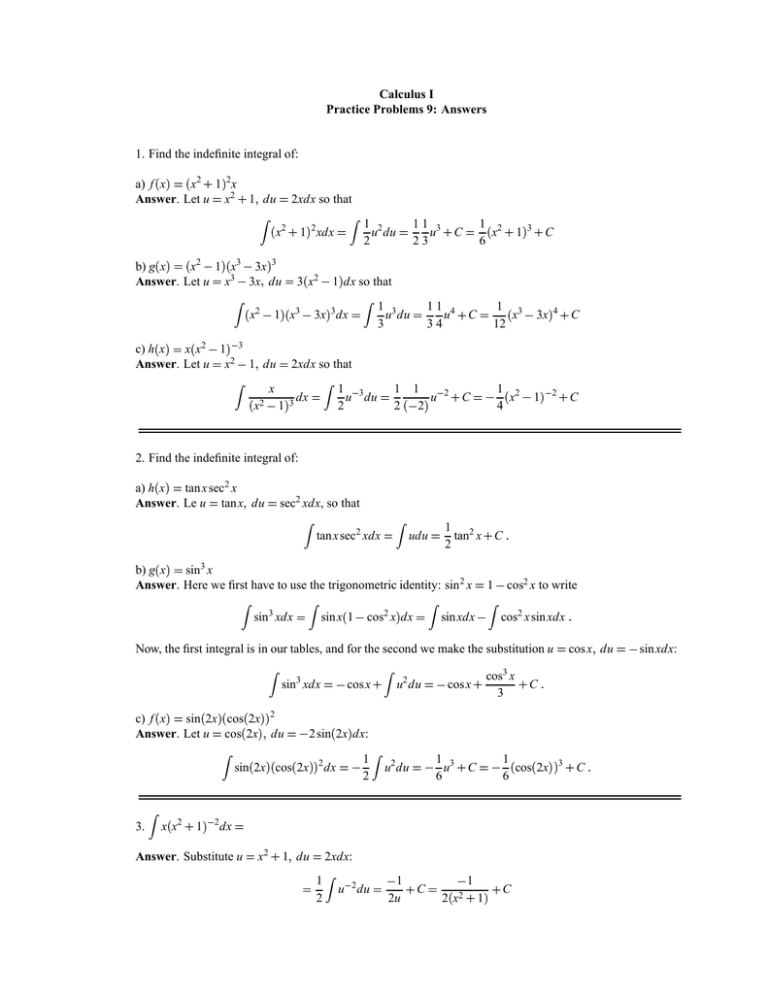
Calculus I Practice Problems 9: Answers 1. Find the indefinite integral of: a) f x x2 1 2x Answer. Let u x2 1 du 2xdx so that x 2 1 xdx 2 11 3 u C 23 1 2 u du 2 1 2 x 1 6 3 C b) g x x2 1 x3 3x 3 Answer. Let u x3 3x du 3 x2 1 dx so that x2 1 x3 3x 3dx 11 4 u C 34 1 3 u du 3 1 3 x 3x 12 4 1 2 x 1 4 2 C c) h x x x2 1 3 Answer. Let u x2 1 du 2xdx so that x x2 1 dx 3 1 3 u du 2 1 2 2 u 1 2 C C 2. Find the indefinite integral of: a) h x tanx sec2 x Answer. Le u tanx du sec2 xdx, so that tanx sec2 xdx 1 2 tan x C 2 udu b) g x sin3 x Answer. Here we first have to use the trigonometric identity: sin2 x 1 cos2 x to write sin3 xdx sin x 1 cos2 x dx sin xdx cos2 x sin xdx Now, the first integral is in our tables, and for the second we make the substitution u cos x du c) f x sin 2x cos 2x 2 Answer. Let u cos 2x du 3. x x2 1 2 cos x sin3 xdx 2 sin 2x dx: sin 2x cos 2x 2 dx 1 2 u2 du u2 du cos x cos3 x 3 1 3 u C 6 1 2 u 2 du 1 2u C 1 2 x2 1 C 1 cos 2x 6 dx Answer. Substitute u x2 1 du 2xdx: C 3 C sin xdx: 4 a) Find the indefinite integral x x 1 dx Answer. First do the multiplication, and then integrate: x1 2 b) Find the indefinite integral x 1 dx x3 2 x1 2 5 x 5 dx 2 2 2 3 x 3 2 C x x 1dx Answer. Here we can’t multiply through, but after the substitution u x 1, we can. For then x u 1 du dx, so 2 5 2 2 3 2 x x 1dx u 1 udu u3 2 u1 2 du C u u 5 3 2 2 x 1 5 2 x 1 3 2 C 5 3 5. Find the solution to the differential equation y y2 x2 y2 such that y 1 2. Answer. By separating the variables we write this as an equation of differentials: x2 1 dx y 2 dy Now we integrate each side: x3 x C 3 2: y 1 and solve for C using the initial condition x 1 y so C 1 2 1 3 1 C 11 6 and 6. Given y dy dx 11 x2 y find y as a function of x. Answer. Rewrite as y 1 x3 3 x y 4 when x 0 1 2 2y1 Using the initial condition x 0 y 4 : 2 4 6 1 2 y 2 x3 3 C 03 3 C, so C 4, and 2y1 which resolves to dy x2 dx 2 x3 6 x3 3 2 4 2 7. Find y as a function of x, given dy dx sin x y y 5 when x 0 Answer. Rewrite as ydy sin xdx, and integrate; y2 2 cos x C. Use the initial condition to find C : 25 2 1 C, so C 27 2. Thus y2 27 2 cosx, or y 27 2 cosx. 8. Find f x given that f 2 1 f 1 1 and f Answer. Integrating, Using f 1 x x x 3. x2 1 2 C x 2 2 2. Put in this value of C and integrate again, getting f x 1 we get C f x Using f 2 1 we get C x3 6 1 x 2 1 2x C 47 12 so f x x3 6 1 x 2 2x 1 47 12 9. An automobile is travelling down the road a speed of 100 ft/sec. a) At what constant rate must the automobile decelerate in order to stop in 300 ft.? b) How long does that take? Answer. Let a be the acceleration to find. The equations of motion are s a 2 v 0 t s0 t 2 At the beginning of the deceleration we have s0 0 v0 equations are (with t now representing the time to stop): From the second, we have t a 2 100t t 2 300 v at v0 100, and at the end s 0 300 v 0. Thus our at 100 100 a, putting that in the first equation we obtain 300 a 104 2 a2 102 from which we obtain 300 104 2a , so that a 102 6 acceleration due to gravity. Finally, t 102 a 6 seconds. 102 a 16 67 ft/sec2 , or slightly more than half the 10. A ball is thrown from ground level so as to just reach the top of a building 150 ft. high. At what initial velocity must the ball be thrown? Answer. Following the equations of motion, we have dv dt 32 ft/sec 2 , so v 32t v0 and s 16t 2 v t, taking the initial conditions s 0 and v is the initial velocity to be found. Our conditions 0 0 0 are that v 0 when s 150, so we have to solve the pair of equations 0 32t v0 150 16t 2 v0t Write t in terms of v0 using the first equation; substitute that expression in the second and solve for v 0 . Alternatively we can use the conservation of energy as expressed in equation (4.45): from which we get v20 64 150, or v0 1 2 v 2 0 32 150 8 150 97 98 ft/sec.
